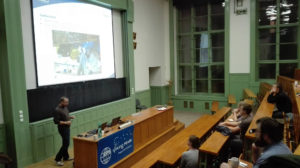 Prague EPS Young Minds section organized a large student meeting at the beginning of the winter semester. It took place at Czech Technical University in Prague in October.
Prague EPS Young Minds section organized a large student meeting at the beginning of the winter semester. It took place at Czech Technical University in Prague in October.
Our section organized event of this kind for the second time. At the beginning of the both meetings, invited speakers gave talk on contemporary and interesting topics. On the first meeting (april 2016), it was about gravitational waves, on the second one it was about the manned and unmanned flights to Mars, one of the most advertised space research activities. This topic was very attractive, thus there were attendance of approximately 50 students. Furthermore, attenders had chance to ask any questions on space research, thus the discussion after the presentation was long and very interesting.
Visitors could enjoy coffee, tea and some snacks, that made the ambience of the meeting very informal and friendly. After the talk, we prepared additional refreshments. This was a great opportunity for students to meet new people, or just to continue in discussion about flights to Mars.
This event was widely advertised. Large numbers of posters was distributed among several academic buildings in Prague. In addition, the information on meeting was spread on social sites of not only our Section, but also of other students´ groups in Prague. Before the talk started, we had presented our section and its future activities, to attract more students.
This event was again generally rated as a good idea. There is no doubt, that such an event is a unique opportunity to connect students of different age and from different universities, via an interesting multidiscipline contemporary presentation, that everybody is interested in.
Physics Pizza Party Season 3
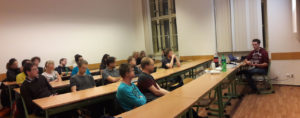 One of the main goals of EPS Young Minds project is to connect young scientists among different physics fields. Therefore, Prague section decided to organize students’ colloquiums named Physics Pizza Party: Students 4 students, where young scientists from different universities and research fields presented their research activities. These events prove to be very successful in winter semester in 2016.
One of the main goals of EPS Young Minds project is to connect young scientists among different physics fields. Therefore, Prague section decided to organize students’ colloquiums named Physics Pizza Party: Students 4 students, where young scientists from different universities and research fields presented their research activities. These events prove to be very successful in winter semester in 2016.
Totally, we organized four colloquiums this semester and for the first time half of the speakers were outside our parent faculty. We had one speaker from Faculty of Electrotechnics (Czech Technical University in Prague) and one from Faculty of Mathematics and Physics (Charles University in Prague). Various themes were presented as: study of solid materials using ultrasound and lasers, algorithms in gambling machines, presentation about superfluid helium and about proposed detector for planned particle collider – Future Circular Collider. All contributions were presented by Ph.D. and master students.
For most of invited speakers, it was their first experience to present their research activities in front of the audience which was not familiar with the topic. Despite of this fact, each talk was perfectly prepared, and therefore there was no problem to understand given topic. Each event was scheduled for about 60 minutes, but with discussion during and after presentation, average time of colloquiums was about 90 minutes and even more. According to the speakers it was very rewarding experience for them.
These events were advertised in form of posters, which were placed in school buildings. For the purpose of inviting as many participants as possible, we also advertised it on our social sites, namely Facebook and Twitter. Thanks to this advertisement, our students’ colloquiums had large attendance. Average number of participants was around 30 students per one colloquium.
The Prague EPS Young Minds Section found these colloquiums rewarding, since this style of presentation “students for students” is still very rare in our country and we were one of the first who organized this style of colloquiums. According to the feedback from our participants, we concluded that our colloquiums were successful, since they were very positively rated by participants. Thanks to these positive feedback and high number of participants, we would like to continue with this activity – this is what students in Prague expect as well.
Physics development in Morocco
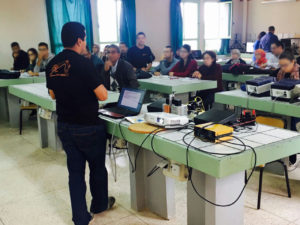 The physics education in secondary schools in Morocco is focused only on theory; the lack of practical work is mainly due to the high price of teaching equipment. Therefore, to improve the quality of Moroccan teaching and to facilitate and approach young physicists to understand the physical phenomena. The USMS PHYSICS Young Minds Section of Beni Mellal has set up several activities during the year 2015-2016 in the context of the transmission of technology to high school students and contribution to several projects that are supervised by the Sultan Moulay Slimane University and other associations. These activities are summarized in the following points:
The physics education in secondary schools in Morocco is focused only on theory; the lack of practical work is mainly due to the high price of teaching equipment. Therefore, to improve the quality of Moroccan teaching and to facilitate and approach young physicists to understand the physical phenomena. The USMS PHYSICS Young Minds Section of Beni Mellal has set up several activities during the year 2015-2016 in the context of the transmission of technology to high school students and contribution to several projects that are supervised by the Sultan Moulay Slimane University and other associations. These activities are summarized in the following points:
• Achievements of practical work’s kits based on simple components for high school students, these kits are:
– Light diffraction kit, to visualize the diffraction phenomena and to calculate the wavelength of the monochromatic light. This Kit is mainly composed of a source of monochromatic light, a slot, a screen and a wooden support.
– Kit for calculating the sound speed in air using an ultrasonic sensor (transmitter and receiver), an obstacle and an acquisition card such as ARDUINO.
– A meteorological station for high school students. This station is composed of various types of sensors (temperature, humidity and solar irradiation) to acquire meteorological data.
• Organization of a summer school, entitled: The experimental physic-chemistry of surfaces and interfaces.
As is it was notified in our activity, the young minds section visited several high schools in the Beni Mellal region such as: Mohammed 5 high school, Ibn sina high school and … (joined flyer file)
There was an interesting contact with the youngest students, they discovered a new relation between theoretical concept and easy experimental setup (pictures file). Also their teachers were also much imprisoned with the equipment homemade, low price and giving correct results.
• Participation in the development of solar energy lighting kits for rural areas in agreement with the association Letter of Light and the association Migration and Co-Development Alsace.
Pizza Physics & Beer
The EPFL YM section was freshly and newly created. As targeted we could organize 3 ‘Pizza Physics Beer’ (PPB) seminars gathering from 20 to 30 people each time. The subjects we explored through these meetings covered nuclear fusion with a visit of the Tokamak reactor of EPFL, ultra hard materials which could be used for propellers and the hazards in nuclear reactor with an analysis of previous nuclear accident and the pertinence of the risk mitigation measures that were taken. This seminar serves now as the flagship event of our interactions within the Physics community at EPFL.
We also organized a visit to IBM Research in Zurich to participate to the event “Hack a Quantum Computer – Getting Involved with the IBM Quantum Experience“. It was the opportunity for us to meet with other EPS and YM members. It triggered the interaction of biophysicists, astrophysicists or condensed matter physicists from the campus around a common topic, namely the birth of quantum cloud computing. These first events made possible by the EPS grant are very encouraging and show us that we can make the EPFL physics community more vivid and interact more widely within the EPS community.
A new dimension
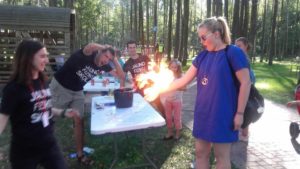 Every year, Riga Young Minds section figures out a new direction in which to grow our School for Young Physicists project – this time, we began expanding our efforts beyond traditional sessions with lectures and tried building physics workshops at various events – such as town fairs, festivals and summer camps for children, even briefly appearing in a TV show.
Every year, Riga Young Minds section figures out a new direction in which to grow our School for Young Physicists project – this time, we began expanding our efforts beyond traditional sessions with lectures and tried building physics workshops at various events – such as town fairs, festivals and summer camps for children, even briefly appearing in a TV show.
Once the season ends in May, we have free time during the summer, and it can be put to good use. Our workshop activities especially ramped up towards the second half of summer 2016 – numerous towns invited us to fairs, we took part in the extreme sports festival “Playground”, appeared on a TV quiz for school students called “eXperiments”, took part in a project that merges humanitarian arts such as song and poetry with the precision of physics, and much more. In these workshops, we take a step away from our typical format, focusing more on the fun one has doing experiments and trying to raise interest in physics by way of the wow-factor. For this reason, we built gadgets such as a huge slingshot and assembled a spud gun.
The workshops appear to have been a success, as we received more and more offers to host our workshops as the summer rolled on and transitioned into autumn. With the beginning of our school year season, these activities have toned down in intensity, but nevertheless happen from time to time. The second semester promises more workshop activities and physics demonstrations, as the yearly TV show will take place again in the spring season and a few other projects take place.
Regional sessions of the School for Young Physicists
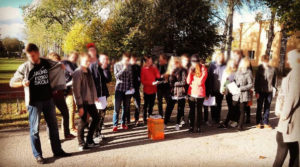 During the 7th season of SYP, Riga Young Minds section has continued to expand our efforts to bring physics education to areas that are further from the capital of Latvia. In addition to the destinations we visited in the past season (Valmiera, Kuldiga and Ventspils), we’ve added another large city to that mix – this year, Liepaja, our most southwestern city, has joined the fold.
During the 7th season of SYP, Riga Young Minds section has continued to expand our efforts to bring physics education to areas that are further from the capital of Latvia. In addition to the destinations we visited in the past season (Valmiera, Kuldiga and Ventspils), we’ve added another large city to that mix – this year, Liepaja, our most southwestern city, has joined the fold.
A variety of topics have been presented – sometimes, topics that have yet to premiere in the capital have test runs, other times, well established (and improved) topics are chosen. Across various cities, lectures on topics such as astronomy, acoustics and forensic science have been given.
Even if the topics repeat in different cities, the approach is often different, because the audience is different – in Kuldiga, it a smaller group of high school students, but in Ventspils, for example, it is a larger group of grade 8 – 9 students. To make the experience as entertaining and valuable as possible, we try to tailor each session to the audience that we’re visiting.
During this semester, the SYP team has visited Valmiera three times, Kuldiga twice, Ventspils twice and Liepaja once. Our aim is to continue holding sessions in these cities in the second half of the school year as well, and plans for adding sessions in another city are in the works.
School for Young Physicists
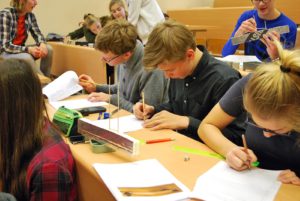 This season marked the seventh anniversary of the main project of our YM section – the School for Young Physicists (SYP). Each month, around 200-250 students from schools all over Latvia gather in the University of Latvia for an entertaining Saturday and to learn some extracurricular physics.
This season marked the seventh anniversary of the main project of our YM section – the School for Young Physicists (SYP). Each month, around 200-250 students from schools all over Latvia gather in the University of Latvia for an entertaining Saturday and to learn some extracurricular physics.
Sessions are held each month, each with a different theme. Every session starts with two popular lectures, 40 minutes in duration, held by physics students of various levels in University of Latvia. In these lectures, topics that generally are not discussed in school are presented in an entertaining manner. Thereafter, participants take a 30-minute break and are treated to a lunch with sandwiches and tea. Then follows the practical part, in which students themselves put the things they’ve just learned to the test. Afterwards another break is held in which students are again treated with food, this time with sweets such as chocolate and cookies and tea. Lastly, a professor or a specialist in the topic is invited for a more in-depth lecture.
A competition called the “School cup” is also held during the season, in which teams of 5 students representing their school do creative tasks assigned to them to come out victorious. Eternal glory and different prizes await for the winners of this competition. This season, 15 different teams are rivaling for the School cup.
On September 24, the seventh season was kicked off with a session titled “Mythologics” in which we discussed how using relatively simple knowledge of physics one can evaluate the plausibility of different claims.
On October 15, the second session of SYP took place. This time, the physics of sound was the topic, and the session was titled “With a physical undertone”.
On the November 12, students gathered to participate in the third session of SYP7 which was titled “Transmitted!” and was about radio-electronics.
On December 10, the last session of the autumn semester was held. Titled “Calculate like a star”, the topic for this session was astronomy.
Specialized talk
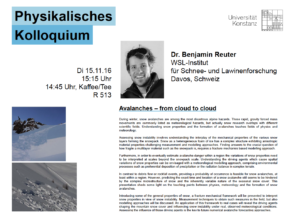 Konstanz jDPG-YM Section organized a specialized talk about a research topic which is not present at the University of Konstanz. The invited speaker was Dr. Benjamin Reuter from the WSL – Institute for snow and avalanche research SLF in Davos, Switzerland. The title of the talk was “Avalanches – from cloud to cloud”. The specialized talk was held in framework of the colloquium of the physical department of the University of Konstanz. In a very impressive way Dr. Reuter introduced the audience to avalanche research and common measurement and forecasting techniques. In the talk he presented some of the general properties of snow and a fracture mechanical framework to interpret snow properties in view of snow instability. He showed measurement techniques to obtain such measures in the field, but also modelling approaches. The presentation indicated that the application of this framework to real cases will reveal the driving agents shaping the mountain snow cover and influencing snow instability under real, observed meteorological conditions. Assessing the influence of those driving agents is the key to future numerical avalanche forecasting approaches.
Konstanz jDPG-YM Section organized a specialized talk about a research topic which is not present at the University of Konstanz. The invited speaker was Dr. Benjamin Reuter from the WSL – Institute for snow and avalanche research SLF in Davos, Switzerland. The title of the talk was “Avalanches – from cloud to cloud”. The specialized talk was held in framework of the colloquium of the physical department of the University of Konstanz. In a very impressive way Dr. Reuter introduced the audience to avalanche research and common measurement and forecasting techniques. In the talk he presented some of the general properties of snow and a fracture mechanical framework to interpret snow properties in view of snow instability. He showed measurement techniques to obtain such measures in the field, but also modelling approaches. The presentation indicated that the application of this framework to real cases will reveal the driving agents shaping the mountain snow cover and influencing snow instability under real, observed meteorological conditions. Assessing the influence of those driving agents is the key to future numerical avalanche forecasting approaches.
Due to the geographical location of Konstanz many of the faculty members are doing snow sports, so our intention to invite a guest who gives insight into a new research topic which is interesting for many faculty members was completely fulfilled. The attendance was significantly above the ordinary and a lot of students were introduced to the colloquium. For us the specialized talk was a great success and we got a lot positive feedback.
School Outreach
The Erlangen YM Section continued their program to visit local schools and tell them about how fundamental science works. With this, they not only showed how research is performed, but gave a peak into the actual life of a researcher. Starting from developing an idea in the shared kitchen of the group, drawing first experimental sketches on the whiteboard and building a first setup – these are the roots of experimental research that get everything else started. Continuing on the topic, the pupils were taught that every experiment and every theory always undergoes some sort of revision process that usually starts with analyzing some measurement results, goes on with a discussion and commonly ends with an adjustment of the experiment or theory. Finally, research needs communication. Without that, nobody would know today about the great achievements of science and nobody could base their work on the millions of papers already published. The pupils (11th grade) were very intrigued by the honest and insightful picture that was given to them and asked many questions both during and after the lecture.
The presentation was accompanied by an experiment that the section brought along to show that whatever was told in the presentation has some realism to it. The pupils were able to make the connection and continue with their questions in a hands-on manner, while being fascinated that single molecules can be resolved by a portable tabletop experiment.
The pupils were not the only ones who learned something. For the Erlangen YM section, it proves to be a valuable lesson to step out of the research lab for a day and do something completely different. Explaining your research during an outreach event grounds you and lets you reconnect to the value of your findings. Through this event, one member of the section was even able to re-visit his old school and delve into past time memories.
Youth Education
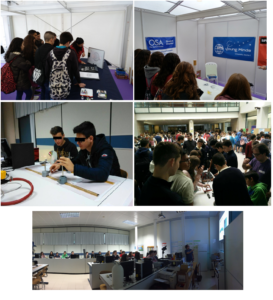 Optical Workshop:
Optical Workshop:
Each year University Jaume I (UJI) of Castellón celebrates the days of dissemination called “Connecta amb la Ciència” (means “Connect with the Science”). These days have the objective of publicize the courses and degrees offered by the scientific area of the UJI. People (teachers, postdocs, students…) working in several areas from the university go to many places around the region of Castellón and offer workshops about chemistry, videogames, optics and photonics, renewable energies, etc. and many high school students attend these workshops.
Taking advantage of the conference “Connecta amb la Ciència” the GOC members have travelled through different towns of the province to bring science to high school students.
We have prepared several micro workshops to show different physical properties and concepts related to optics (atmospheric scattering, refraction, diffraction on a CD, light absorption, polarization…) and also explain how works the human eye. In this way, students from all region have the opportunity to learn science by having fun.
We showed these workshops in 2014 and 2015 and teachers from different high schools requested our workshops also for this year 2016 because the students enjoyed them. This year we have visited three towns, Teruel (9/11/2016), Villarreal (24/11/2016) and Sagunto (29/11/2016). We have some new material for improve our explanations, as for example fluorescent sheets and UV lasers. This activity reached up to 200 students from several places.
First contact with the university:
The second week of January we offered to students in last high school year several seminars. Firstly, we started the sessions with the presentation of our group GOC and our ongoing and future activities. After we showed them some light properties, they made a practical activity related with diffraction to guess if they have a DVD or a CD.
FIRUJI-CIENCIA:
On May took place an activity developed by UJI called FIRUJICIÈNCIA where students from high school and university had the chance to see science demonstrations in different stands. There we showed them some characteristics of light and its application. We explained polarization by using two polarizers and allowing the students to cross them or to move them freely. We made a photoelasticity demonstration, with two crossed polarizers, we told them to add a transparent medium between both and they could see the effect of the material on light. They could also see refraction and reflection, with a glass of water and a coin we explained them the phenomenon of the total internal reflection and the critical angle. We cloaked the coin while it was under the glass, in air, and show them how depending on the angle of observation you can see it or not. Diffraction demonstration were also developed, we used diffraction gratings and lasers of different wavelength to make clear the dependence of the angle of the diffraction orders with that parameter. We had a model of the human eye and lenses to simulate image formation and to let them see the effect of myopia and hyperopia and how to correct them using lenses.
